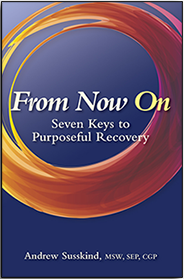Traditionally, twelve-step programs describe addiction with borrowed language from the medical model such as disease, illness, and even the word addiction itself. Yet, there’s less shameful and stigmatizing ways to talk about it.
In 1998, Dr. Marty Seligman, a psychologist at the University of Pennsylvania coined the term Positive Psychology, and a like-minded, international community of researchers came out of the woodwork. Not only did they open the door to expanded research in this brand-new field, but they also paved the way toward its application toward addictive and compulsive behaviors.
Instead of focusing on what’s wrong with clients, Positive Psychologists began to talk about what’s right. Exploring strengths became center stage, and existential-spiritual questions such as “What gives you a reason to wake up in the morning”? and “What makes life worth living?” became part of the new dialogue.
Positive Psychology is a future-focused, action-oriented, wellness model focusing on purpose, resilience and regulation. Rather than solely focusing on deficits, resourcefulness and signature strengths get fully explored. And these are essential ingredients for long-term sustainable recovery.
As a recovering sex addict, you chose to stop your out-of-control behaviors and began to experience a bigger life with greater possibilities. In early recovery, you acknowledged your tendencies to self-attack and self-sabotage, and eventually, it was time to leverage your resources and identify your deeper wants and desires. Milestones of long-term recovery include: emotional sobriety, meaningful connection, gratitude, joy and contentment—all elements related to Positive Psychology.
Sex addiction fellowships tend to be smaller than established groups like AA resulting in fewer old-timers in the rooms. As a result, newcomers often focus more on the problem rather than the solution. Taking the lead from oldtimers as well as Positive Psychology, it would be remarkable to see what would happen if meetings would focus more on purpose, priorities and possibilities.
I once heard a chaplain describe spirituality as “whatever gives your life meaning.” Because Positive Psychology describes meaning and engagement as pillars of happiness, those in recovery are challenged to investigate this territory. As recovery deepens, ask yourself, “What brings meaning and engagement to my recovery?”
In addition to traditional resentment inventories, develop a joy and gratitude inventory to counterbalance your fourth step. Begin with an early memory of joy or gratitude, and list as many memories as possible. Focus on positive life events to carve out new neural pathways as well as greater awareness of pleasant life events.
Deepak Chopra’s book Overcoming Addiction states that the absence of joy is the cause and the effect of addiction. This reminds us that joy can be a safety net from future problematic behaviors. As joy becomes a practice, here is a litmus test for you. Does this person, place, thing or experience nourish or deplete you? Ask yourself this question, and it will reveal what belongs in your life or not.
Twelve-step wisdom reminds you that there are Three S’s—service, spirituality and self-care—all fundamental elements leading to greater contentment. Being of service is an antidote to the self-centeredness of addiction. Because addictions are narcissistic by definition, shifting toward other-centeredness breaks the cycle.
Spirituality does not have to be a place of worship or any type of dogma. I believe there are more questions than there are answers so keep asking the big ticket questions, and don’t feel pressure to have specific answers. Keep it simple and try not to pressure yourself to clearly define what gives your life meaning.
Impeccable self-care might seem to contradict the idea of being of service, yet how can you be there for others if you don’t take good care of yourself? Just like on a plane, you need to put the oxygen mask on yourself first. Because you’ve had gaps in the parenting you received, now is a time to re-parent yourself and receive loving parenting from others.
Celebrate your sexual self. Because any type of touch could be sexualized in the past, it’s essential to discover ways to touch and be touched safely. Hugs, cuddling and therapeutic massage are just a few examples of practicing safer touch, and each of these possibilities can help you experience safe physical intimacy and body awareness rather than keeping you in old patterns. Discuss your options with a confidant.
“What matters most to you”? “What is something that puts a smile on your face”? By identifying core values, passions and priorities, you’ll develop purposeful action steps. Once you establish your vision, find an accountability partner to stay on track with your heart’s intentions.
Neuroplasticity describes how synaptic connections in the brain expand through focus and attention. For example, if you get stuck in shame and resentment, synaptic connections multiply around these well-worn paths. If you focus on joy, gratitude and well-being, your brain creates brand-new neural pathways pointing you toward deeper contentment and connection.
Positive Psychology opens the aperture to endless possibilities. It’s not meant to be a stand-alone approach, but it adds a fresh dimension to explore and develop happiness and purpose. Now apply it to your recovery and see what happens.




